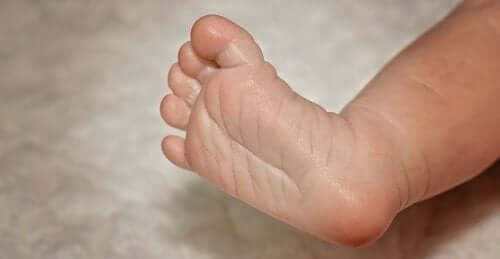Everything You Need to Know About Flat Feet

People with flat feet have an arch that is lower than normal on the soles of their feet. This means that one or both feet can be flat on the ground. It’s a condition that only needs treatment if it’s uncomfortable because it could indicate a disorder or cause pain in other parts of the body. In this article, we’ll tell you everything about it.
Flat feet can be hereditary, just like facial features or eye color. While most babies are born with flat feet, arches start forming around three years old. That is to say that upon reaching adulthood, this condition will fix itself.
On the contrary, some people never develop an arch, and may or may not experience difficulties as a result. Let’s see what the symptoms are, the treatment, and how this affects little ones.
What are the symptoms of flat feet?
Many people with flat feet have no symptoms, but others feel different consequences that usually depend on the severity of the condition. In any case, the most common symptom is foot pain.
This disorder can also cause an uneven distribution of body weight. As a result, shoes wear unevenly or faster than normal, especially on the side. In fact, these can lead to more injuries.
On the other hand, flat feet can also cause tension and misalignment in the ankles, which force the feet to move inward.
Many people have this condition and don’t notice any problems, in which case they won’t need treatment. Meanwhile, others feel symptoms like pain in these parts of the body: arch of the foot, hips, lower back, legs and feet. Of course, we recommend seeing your doctor if you feel any of this pain.

Treatment
This is a condition in which the feet don’t have a normal arch. It can affect one of the lower extremities or both. Most of the time, going to the podiatrist is a step in the right direction for treatment.
Using insoles or wearing shoes with more arch support can also help relieve some of the discomfort.
Similarly, reducing activities that cause pain is another piece of advice that could help you. Even losing weight can help if your feet need to carry excess weight in the arches.
Certainly, non-surgical treatment options like wearing different shoes, resting and medications can be very effective in controlling pain and being able to use your feet normally. Generally, this is the best approach. Surgery is usually only for very extreme cases.
“While most babies are born with flat feet, arches start to form around three years old.”
Flat feet in children
Most young children have this problem in their feet. Arches usually aren’t fully formed. However, they keep growing as the years go on. Over time, they should develop normally.
In some cases, extra fat in babies’ feet can hide their arch. Therefore, having this condition during the first few years of childhood doesn’t mean they’ll always have them.

However, if a child has flat feet as a result of improper bone development or another condition, the doctor needs to treat the underlying cause. Of course, if the child complains of lots of pain in his feet or ankles, it’s probably time to take him to the doctor.
This condition in older kids can cause pain in their heels or arches. In addition, running or walking can be uncomfortable. While most kids will develop arches around six years old, some might have delays or deformities that interfere with normal bone development.
As we mentioned earlier, this condition in kids doesn’t require treatment. Usually, arches develop in adolescence or early adulthood.
Finally, don’t forget that if your child has this condition, you need to take him to a podiatrist if the pain stops him from doing normal activities, like walking or exercising. Although it’s not something you can prevent, early treatment will help prevent pain and discomfort.
People with flat feet have an arch that is lower than normal on the soles of their feet. This means that one or both feet can be flat on the ground. It’s a condition that only needs treatment if it’s uncomfortable because it could indicate a disorder or cause pain in other parts of the body. In this article, we’ll tell you everything about it.
Flat feet can be hereditary, just like facial features or eye color. While most babies are born with flat feet, arches start forming around three years old. That is to say that upon reaching adulthood, this condition will fix itself.
On the contrary, some people never develop an arch, and may or may not experience difficulties as a result. Let’s see what the symptoms are, the treatment, and how this affects little ones.
What are the symptoms of flat feet?
Many people with flat feet have no symptoms, but others feel different consequences that usually depend on the severity of the condition. In any case, the most common symptom is foot pain.
This disorder can also cause an uneven distribution of body weight. As a result, shoes wear unevenly or faster than normal, especially on the side. In fact, these can lead to more injuries.
On the other hand, flat feet can also cause tension and misalignment in the ankles, which force the feet to move inward.
Many people have this condition and don’t notice any problems, in which case they won’t need treatment. Meanwhile, others feel symptoms like pain in these parts of the body: arch of the foot, hips, lower back, legs and feet. Of course, we recommend seeing your doctor if you feel any of this pain.

Treatment
This is a condition in which the feet don’t have a normal arch. It can affect one of the lower extremities or both. Most of the time, going to the podiatrist is a step in the right direction for treatment.
Using insoles or wearing shoes with more arch support can also help relieve some of the discomfort.
Similarly, reducing activities that cause pain is another piece of advice that could help you. Even losing weight can help if your feet need to carry excess weight in the arches.
Certainly, non-surgical treatment options like wearing different shoes, resting and medications can be very effective in controlling pain and being able to use your feet normally. Generally, this is the best approach. Surgery is usually only for very extreme cases.
“While most babies are born with flat feet, arches start to form around three years old.”
Flat feet in children
Most young children have this problem in their feet. Arches usually aren’t fully formed. However, they keep growing as the years go on. Over time, they should develop normally.
In some cases, extra fat in babies’ feet can hide their arch. Therefore, having this condition during the first few years of childhood doesn’t mean they’ll always have them.

However, if a child has flat feet as a result of improper bone development or another condition, the doctor needs to treat the underlying cause. Of course, if the child complains of lots of pain in his feet or ankles, it’s probably time to take him to the doctor.
This condition in older kids can cause pain in their heels or arches. In addition, running or walking can be uncomfortable. While most kids will develop arches around six years old, some might have delays or deformities that interfere with normal bone development.
As we mentioned earlier, this condition in kids doesn’t require treatment. Usually, arches develop in adolescence or early adulthood.
Finally, don’t forget that if your child has this condition, you need to take him to a podiatrist if the pain stops him from doing normal activities, like walking or exercising. Although it’s not something you can prevent, early treatment will help prevent pain and discomfort.
This text is provided for informational purposes only and does not replace consultation with a professional. If in doubt, consult your specialist.








